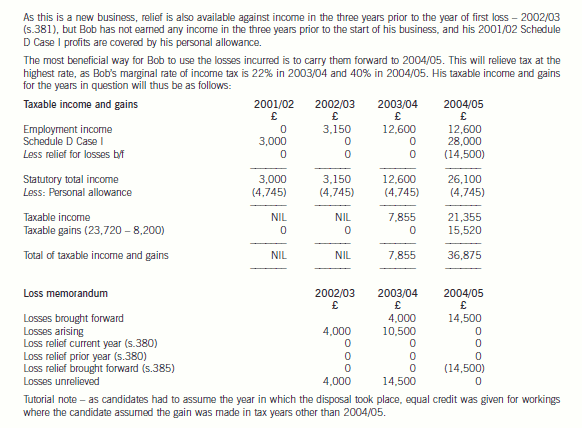第1题:
What does Karen Pickering put on top of her diary?
A. Her training schedule.
B. Her daily happenings.
C. Her achievements.
D. Her sports career.
第2题:
(ii) Calculate her income tax (IT) and national insurance (NIC) payable for the year of assessment 2006/07.
(4 marks)

第3题:
Mary has just returned to the USA after studying in England for three years. She decided to study at a British university rather than an American one because her mother is from England and she wanted to get to know her mother抯 family better. She studied English Literature at Goldsmiths?College, which is in London. She lived with her grandmother while she was studying. The college was recommended by a friend抯 brother who had studied in England for his MBA. Mary told her friends that she was going to return to Europe to work because she had enjoyed her time in England so much.
(1). Mary is now in ().
A、 England
B、France
C、the USA
(2). She studied at () university.
A、a Chinese
B、an American
C、a British
(3). Most probably, her grandmother ().
A、 worked in the college
B、lived in London
C、studied English Literature
(4). Her friend’s brother recommended her to ().
A、 study in the college
B、study for her MBA
C、work for his company
(5). Mary would return to Europe to ().
A、 study
B、spend her holiday
C、work
第4题:
(c) Explain the capital gains tax (CGT) and income tax (IT) issues Paul and Sharon should consider in deciding
which form. of trust to set up for Gisella and Gavin. You are not required to consider inheritance tax (IHT) or
stamp duty land tax (SDLT) issues. (10 marks)
You should assume that the tax rates and allowances for the tax year 2005/06 apply throughout this question.
第5题:
(ii) Explain the income tax (IT), national insurance (NIC) and capital gains tax (CGT) implications arising on
the grant to and exercise by an employee of an option to buy shares in an unapproved share option
scheme and on the subsequent sale of these shares. State clearly how these would apply in Henry’s
case. (8 marks)
第6题:
(c) Assuming that Joanne registers for value added tax (VAT) with effect from 1 April 2006:
(i) Calculate her income tax (IT) and capital gains tax (CGT) payable for the year of assessment 2005/06.
You are not required to calculate any national insurance liabilities in this sub-part. (6 marks)

第7题:
(b) Assuming that the income from the sale of the books is not treated as trading income, calculate Bob’s taxable
income and gains for all relevant tax years, using any loss reliefs in the most tax-efficient manner. Your
answer should include an explanation of the loss reliefs available and your reasons for using (or not using)
them. (12 marks)
Assume that the rates and allowances for 2004/05 apply throughout this part of the question.


第8题:
PERSONAL INCOME TAX RATE (MONTHLY) (_VALID FROM SEPT. 1, 2011_) bracket grading tax rate (%) (TR) simple coefficient (SC) 1 less than 1,500 3 0 2 1,500-4,500 10 105 3 4,500-9,000 20 555 4 9,000-35,000 25 1005 5 35,000-55,000 30 2755 6 55,000-80,000 35 5505 7 Over 80,000 45 13505 NoteTax=(income -3500)*TR-SC The above chart shows individual income tax in China. The tax free threshold is 3,500 RMB per month. The tax rates are divided into 7 brackets. The lowest rate is 3% for income between 3,501 and 5,000, while the highest rate is 45% for income over 80,000. Therefore, the higher our income is, the more tax we should pay. ? Tax, which can be used in public services such as education, road construction, public health and so on, is very important to our country. As we all know, tax makes up a great part of our country’s revenue, and the development of our country depends on it. ? From what has been discussed above, we can see that it is everyone’s legal duty to pay tax because taxes contribute to the country and create benefits for everyone. Those who try to evade taxation are sure to be punished. In short, paying tax is our responsibility to society. DECIDE IF EACH OF THE FOLLOWING STATEMENTS IS TRUE (T) OR FALSE (F).
1. The purpose of the passage is to help people know the tips how to pay less tax.()
2. According to the chart, if a person’s monthly is 3600 yuan, he/she doesn’t need to pay tax.()
3. How much income tax a person pays each month depends on how much his/her income is.()
4. The underlined word “evade” in the last paragraph means increase.()
5. Personal income taxes are included in a government’s revenue.()
第9题:
(c) Outline the ways in which Arthur and Cindy can reduce their income tax liability by investing in unquoted
shares and recommend, with reasons, which form. of investment best suits their circumstances. You are not
required to discuss the qualifying conditions applicable to the investment vehicle recommended. (5 marks)
You should assume that the income tax rates and allowances for the tax year 2005/06 apply throughout this
question
第10题:
(iii) State the value added tax (VAT) and stamp duty (SD) issues arising as a result of inserting Bold plc as
a holding company and identify any planning actions that can be taken to defer or minimise these tax
costs. (4 marks)
You should assume that the corporation tax rates for the financial year 2005 and the income tax rates
and allowances for the tax year 2005/06 apply throughout this question.